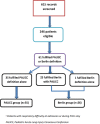Comparison of Prevalence and Outcomes of Pediatric Acute Respiratory Distress Syndrome Using Pediatric Acute Lung Injury Consensus Conference Criteria and Berlin Definition
- PMID: 29686979
- PMCID: PMC5900438
- DOI: 10.3389/fped.2018.00093
Comparison of Prevalence and Outcomes of Pediatric Acute Respiratory Distress Syndrome Using Pediatric Acute Lung Injury Consensus Conference Criteria and Berlin Definition
Abstract
Objectives: Our objective was to compare the prevalence and outcomes of pediatric acute respiratory distress syndrome using the Pediatric Acute Lung Injury Consensus Conference (PALICC) criteria and Berlin definitions.
Methods: We screened case records of all children aged 1 month to 17 years of age admitted to the Pediatric Intensive Care Unit (PICU) over a 3-year period (2015-2017) for presence of any respiratory difficulty at admission or during PICU stay. We applied both PALICC and Berlin criteria to these patients. Data collection included definition and outcome related variables. Data were compared between the "PALICC only group" and the "Berlin with or without PALICC" group using Stata 11.
Results: Of a total of 615 admissions, 246 were identified as having respiratory difficulty at admission or during PICU stay. A total of 61 children (prevalence 9.9%; 95% CI: 7.8-12.4) fulfilled the definition of acute respiratory distress syndrome (ARDS) with either of the two criteria. While 60 children (98%) fulfilled PALICC criteria, only 26 children (43%) fulfilled Berlin definition. There was moderate agreement between the two definitions (Kappa: 0.51; 95% CI: 0.40-0.62; observed agreement 85%). Greater proportion of patients had severe ARDS in the "Berlin with or without PALICC group" as compared to the "PALICC only" group (50 vs. 19%). There was no difference between the groups with regard to key clinical outcomes such as duration of ventilation (7 vs. 8 days) or mortality [51.4 vs. 57.7%: RR (95% CI): 0.99 (0.64-1.5)].
Conclusion: In comparison to Berlin definition, the PALICC criteria identified more number of patients with ARDS. Proportion with severe ARDS and complications was greater in the "Berlin with or without PALICC" group as compared to the "PALICC only" group. There were no differences in clinical outcomes between the groups.
Keywords: Berlin definition; PALICC criteria; Pediatric Acute Lung Injury Consensus Conference definition; acute respiratory distress syndrome; oxygen saturation index; oxygenation index; pediatric acute respiratory distress syndrome.
Figures
Similar articles
-
Definition and global epidemiology of pediatric acute respiratory distress syndrome.Ann Transl Med. 2019 Oct;7(19):502. doi: 10.21037/atm.2019.09.31. Ann Transl Med. 2019. PMID: 31728355 Free PMC article. Review.
-
Performance of acute respiratory distress syndrome definitions in a high acuity paediatric intensive care unit.Respir Res. 2021 Sep 29;22(1):256. doi: 10.1186/s12931-021-01848-z. Respir Res. 2021. PMID: 34587946 Free PMC article.
-
Paediatric acute respiratory distress syndrome incidence and epidemiology (PARDIE): an international, observational study.Lancet Respir Med. 2019 Feb;7(2):115-128. doi: 10.1016/S2213-2600(18)30344-8. Epub 2018 Oct 22. Lancet Respir Med. 2019. PMID: 30361119 Free PMC article.
-
Evaluating the Performance of the Pediatric Acute Lung Injury Consensus Conference Definition of Acute Respiratory Distress Syndrome.Pediatr Crit Care Med. 2017 Jan;18(1):17-25. doi: 10.1097/PCC.0000000000000945. Pediatr Crit Care Med. 2017. PMID: 27673384
-
Pediatric acute respiratory distress syndrome: definition, incidence, and epidemiology: proceedings from the Pediatric Acute Lung Injury Consensus Conference.Pediatr Crit Care Med. 2015 Jun;16(5 Suppl 1):S23-40. doi: 10.1097/PCC.0000000000000432. Pediatr Crit Care Med. 2015. PMID: 26035358
Cited by
-
Definition and global epidemiology of pediatric acute respiratory distress syndrome.Ann Transl Med. 2019 Oct;7(19):502. doi: 10.21037/atm.2019.09.31. Ann Transl Med. 2019. PMID: 31728355 Free PMC article. Review.
-
Steroids in pediatric acute respiratory distress syndrome.Ann Transl Med. 2019 Oct;7(19):508. doi: 10.21037/atm.2019.07.77. Ann Transl Med. 2019. PMID: 31728361 Free PMC article. Review.
-
What do we know about optimal nutritional strategies in children with pediatric acute respiratory distress syndrome?Ann Transl Med. 2019 Oct;7(19):510. doi: 10.21037/atm.2019.08.25. Ann Transl Med. 2019. PMID: 31728363 Free PMC article. Review.
-
Performance of acute respiratory distress syndrome definitions in a high acuity paediatric intensive care unit.Respir Res. 2021 Sep 29;22(1):256. doi: 10.1186/s12931-021-01848-z. Respir Res. 2021. PMID: 34587946 Free PMC article.
-
Pediatric Acute Respiratory Distress Syndrome in India: Time for Collaborative Study?Indian J Crit Care Med. 2022 Aug;26(8):896-897. doi: 10.5005/jp-journals-10071-24300. Indian J Crit Care Med. 2022. PMID: 36042766 Free PMC article.
References
-
- Ashbaugh DG, Bigelow DB, Petty TL, Levine BE. Acute respiratory distress in adults. Crit Care Resusc (2005) 7:60–1. - PubMed
LinkOut - more resources
Full Text Sources
Other Literature Sources


